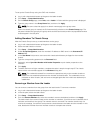
• If you type racadm getconfig -f <filename> .cfg, the command builds a .cfg file for the
current CMC configuration. This configuration file can be used as an example and as a starting point
for your unique .cfg file.
Parsing Rules
• Lines that start with a hash character (#) are treated as comments.
A comment line must start in column one. A "#" character in any other column is treated as a #
character.
Some modem parameters may include # characters in their strings. An escape character is not
required. You may want to generate a .cfg from a racadm getconfig -f <filename> .cfg
command, and then perform a racadm config -f <filename> .cfg command to a different
CMC, without adding escape characters.
For example:
#
# This is a comment
[cfgUserAdmin]
cfgUserAdminPageModemInitString= <Modem init # not
a comment>
• All group entries must be surrounded by open- and close-brackets ([ and ]).
The starting [ character that denotes a group name must be in column one. This group name must be
specified before any of the objects in that group. Objects that do not include an associated group
name generate an error. The configuration data is organized into groups as defined in the database
property chapter of the Chassis Management Controller for PowerEdge VRTX RACADM Command
Line Reference Guide. The following example displays a group name, object, and the object’s property
value:
[cfgLanNetworking] -{group name}
cfgNicIpAddress=143.154.133.121 {object name}
{object value}
• All parameters are specified as "object=value" pairs with no white space between the object, =, or
value. White spaces that are included after the value are ignored. A white space inside a value string
remains unmodified. Any character to the right of the = (for example, a second =, a #, [, ], and so on)
is taken as-is. These characters are valid modem chat script characters.
[cfgLanNetworking] -{group name}
cfgNicIpAddress=143.154.133.121 {object value}
• The .cfg parser ignores an index object entry.
You cannot specify which index is used. If the index already exists, it is either used or the new entry is
created in the first available index for that group.
The racadm getconfig -f <filename>.cfg command places a comment in front of index
objects, allowing you to see the included comments.
NOTE: You may create an indexed group manually using the following command:
racadm config -g <groupname> -o <anchored object> -i <index 1-4>
<unique anchor name>
• The line for an indexed group cannot be deleted from a .cfg file. If you do delete the line with a text
editor, RACADM stops when it parses the configuration file and alert you of the error.
You must remove an indexed object manually using the following command:
racadm config -g <groupname> -o <objectname> -i <index 1-4> ""
95


















